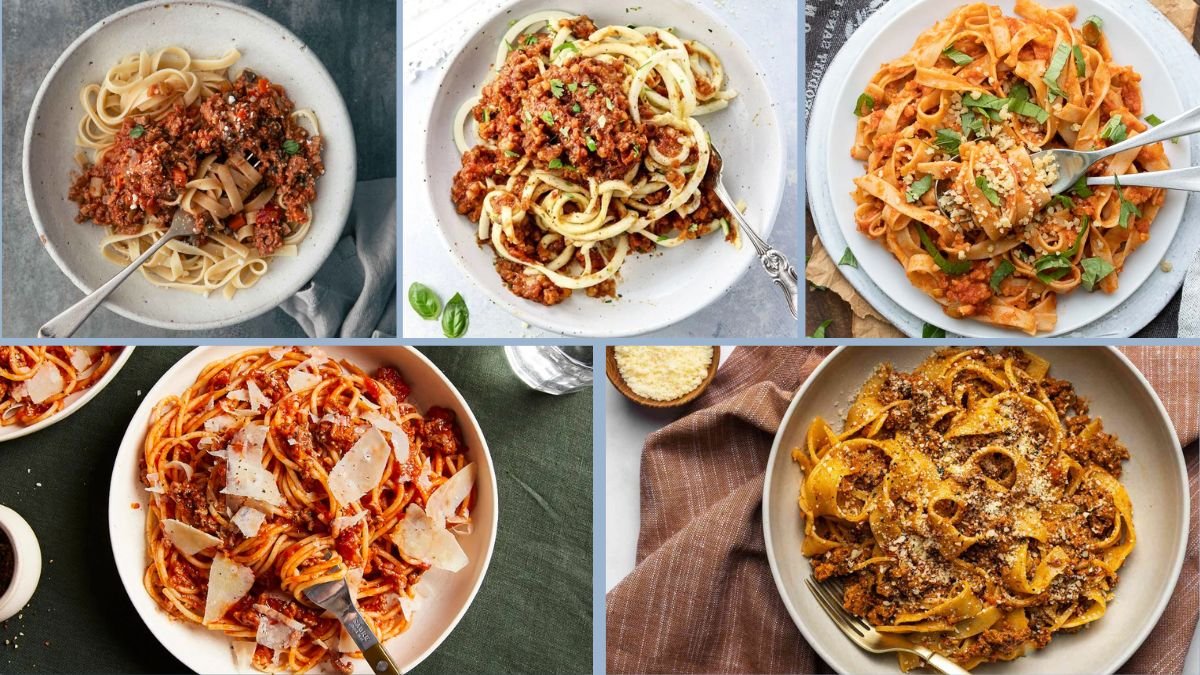Bolognese sauce is an Italian classic, traditionally a rich, slow-cooked meat sauce often served with pasta, lasagna, or polenta. However, it is entirely possible to recreate this hearty, deeply flavorful dish without meat, using vegetables, legumes, and seasonings that mimic the umami and richness of traditional Bolognese. A well-made vegetarian Bolognese offers a satisfying, nutritious, and versatile meal suitable for plant-based diets while retaining the depth of flavor that makes the classic beloved worldwide.
Achieving a flavorful vegetarian Bolognese requires attention to ingredient selection, layering of flavors, proper cooking technique, and seasoning balance. Here are nine essential tricks for crafting the perfect meat-free Bolognese.
Trick 1: Choose the Right Base Vegetables
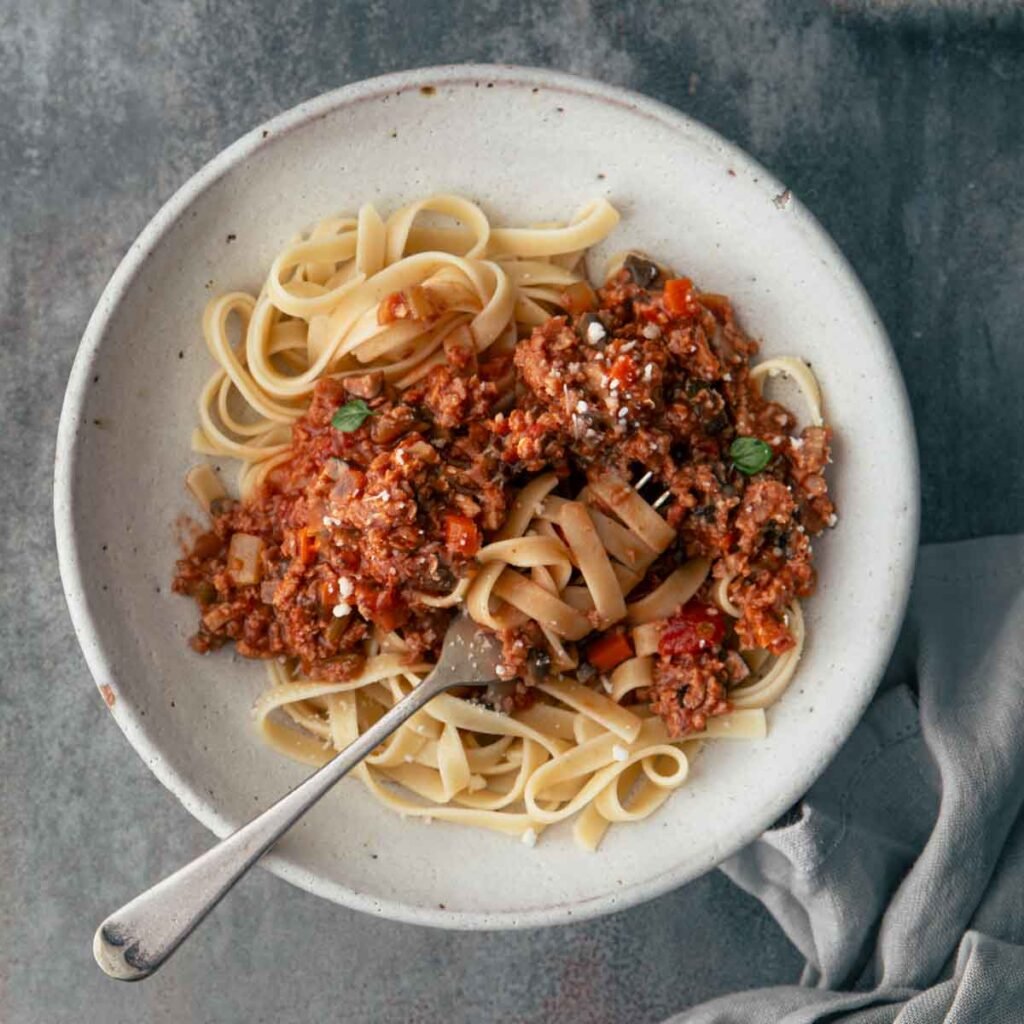
The foundation of vegetarian Bolognese is vegetables that provide flavor, texture, and body.
- Aromatic Vegetables: Onion, carrots, and celery (soffritto) are essential for depth and sweetness.
- Mushrooms: Finely chopped mushrooms provide a meaty texture and natural umami flavor.
- Optional Additions: Bell peppers, zucchini, or parsnips can enhance flavor complexity.
Pro Tip: Dice vegetables uniformly to ensure even cooking and a smooth, cohesive sauce.
Science Insight: The Maillard reaction during sautéing caramelizes natural sugars in vegetables, contributing to a rich, savory flavor base.
Trick 2: Incorporate Legumes for Hearty Texture
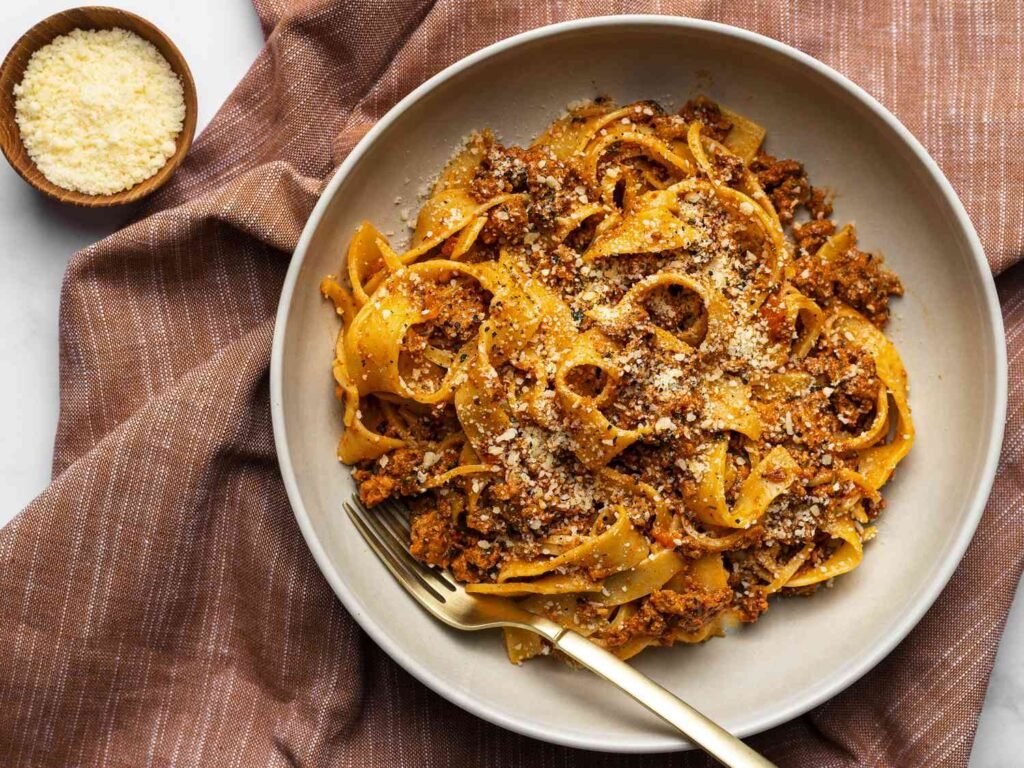
Legumes like lentils or chickpeas mimic the texture of ground meat and boost protein content.
- Lentils: Brown or green lentils hold their shape during cooking and provide a satisfying bite.
- Chickpeas: Slightly mashed chickpeas add bulk and creaminess.
- Cooking: Pre-cook or use canned legumes, drained and rinsed, before adding to the sauce.
Pro Tip: Combine finely chopped vegetables and legumes for a balanced texture that resembles traditional Bolognese.
Culinary Insight: Legumes’ protein and starch content interact with the sauce, absorbing flavors and thickening the mixture naturally.
Trick 3: Use a Flavorful Tomato Base
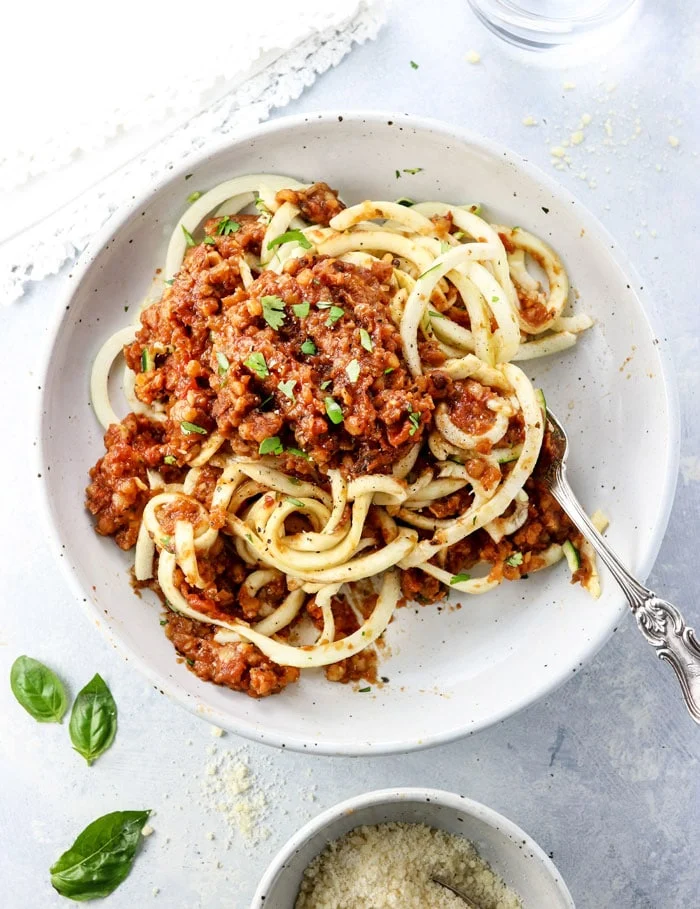
Tomatoes are central to Bolognese, providing acidity, sweetness, and umami.
- Varieties: Use canned whole or crushed tomatoes, or ripe fresh tomatoes for a fresher taste.
- Concentration: Simmer sauce gently to reduce liquid and intensify flavor.
- Tomato Paste: Adds richness, color, and a slightly caramelized taste when sautéed with the vegetables.
Pro Tip: Blend part of the tomatoes for a smoother sauce while leaving some chunks for texture.
Science Insight: Slow simmering allows acids and sugars in tomatoes to break down, creating a naturally balanced and concentrated flavor.
Trick 4: Layer Flavors with Herbs and Spices
Herbs and spices elevate the sauce, making it aromatic and complex.
- Classic Herbs: Basil, oregano, thyme, and bay leaves complement the sauce naturally.
- Additional Spices: Smoked paprika, nutmeg, or red pepper flakes enhance depth and warmth.
- Timing: Add dried herbs early and fresh herbs near the end to preserve aroma.
Pro Tip: Toast spices briefly in oil to release their essential oils before adding tomatoes or liquid.
Culinary Insight: Layering flavors at different cooking stages builds complexity, making a simple vegetarian sauce taste rich and multi-dimensional.
Trick 5: Enhance Umami
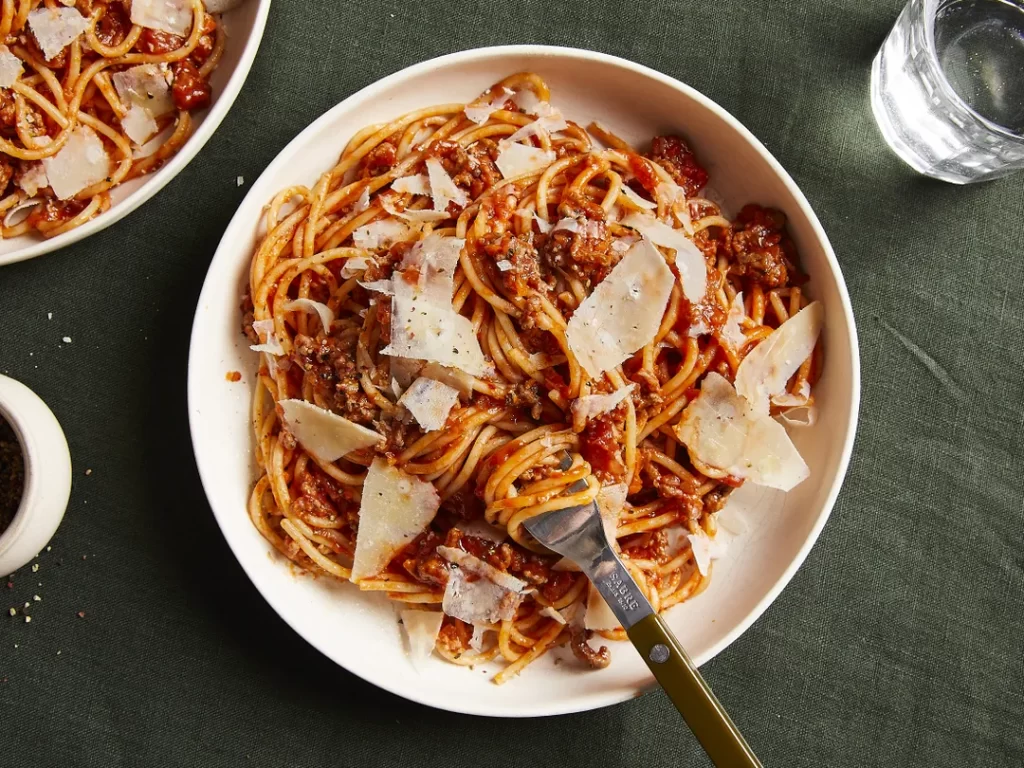
Umami, the savory “fifth taste,” is key to replicating the depth of traditional Bolognese.
- Mushrooms: Add finely chopped or minced mushrooms for natural glutamates.
- Soy Sauce or Tamari: Provides depth and enhances savory notes.
- Nutritional Yeast: Optional addition for cheesy, umami-rich flavor without dairy.
Pro Tip: Avoid over-salting early; umami boosters intensify flavors gradually during cooking.
Science Insight: Glutamates in mushrooms, soy, and nutritional yeast trigger the umami receptors on the tongue, creating a perception of richness and depth.
Trick 6: Deglaze and Build Layers
Deglazing and layering liquids enhances flavor complexity.
- Vegetable Broth: Use as the main liquid to simmer the sauce and add depth.
- Red Wine or Balsamic Vinegar: Optional splash adds acidity and richness, balancing the sweetness of tomatoes.
- Technique: Add liquid gradually, allowing it to reduce before adding more.
Pro Tip: Use a wooden spoon to scrape browned bits from the bottom of the pan during deglazing—they contain concentrated flavor.
Culinary Insight: Deglazing captures all browned residues, enhancing the sauce’s richness and complexity without meat.
Trick 7: Cook Slowly for Maximum Flavor
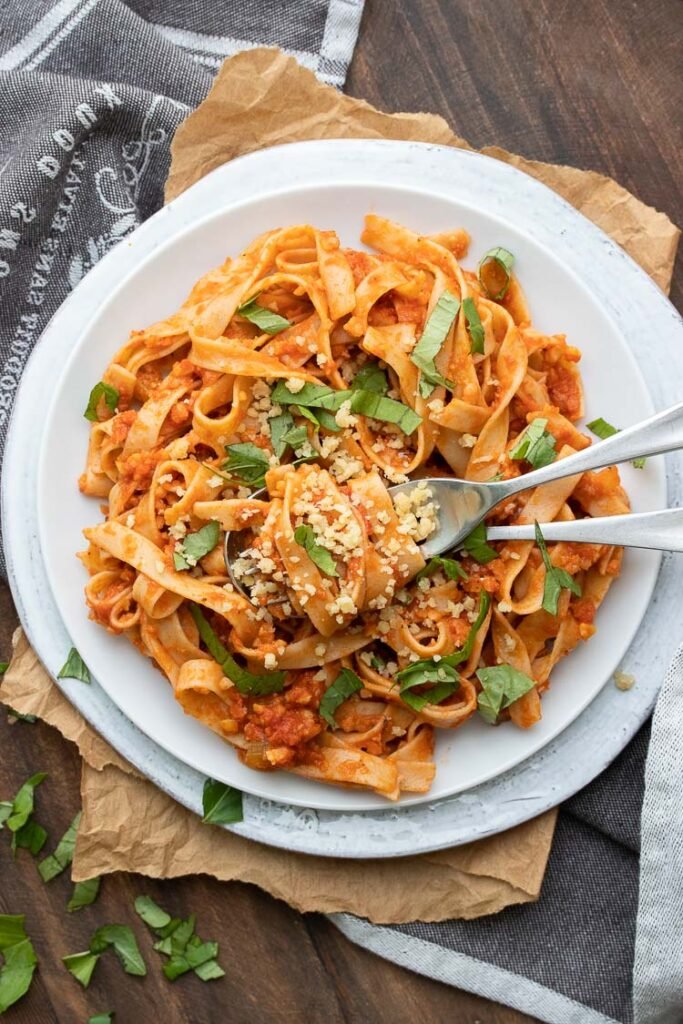
Patience is essential for developing a rich Bolognese.
- Simmering Time: Cook gently for 30–60 minutes to allow flavors to meld.
- Consistency: Stir occasionally to prevent sticking; reduce liquid gradually for a thick, hearty sauce.
- Low Heat: Prevents vegetables and tomatoes from burning while preserving delicate aromas.
Pro Tip: Taste periodically and adjust seasoning as flavors concentrate during simmering.
Science Insight: Slow cooking allows enzymatic breakdown of vegetables and legumes, melding flavors and creating a unified, savory sauce.
Trick 8: Balance Acidity, Sweetness, and Salt
A perfectly balanced sauce has harmony between tangy, sweet, and savory notes.
- Acid: Tomatoes and optional vinegar provide tanginess.
- Sweetness: Caramelized vegetables or a small pinch of sugar balances acidity.
- Salt: Enhances all flavors, but add gradually to avoid over-seasoning.
Pro Tip: Taste frequently and adjust each element toward the end of cooking for the most balanced result.
Flavor Insight: Proper balance prevents the sauce from tasting flat, harsh, or one-dimensional.
Trick 9: Serve with Complementary Pasta or Dishes
Vegetarian Bolognese is versatile and pairs well with many options:
- Pasta: Traditional spaghetti, tagliatelle, or pappardelle.
- Polenta: Creamy polenta adds another layer of texture.
- Garnishes: Fresh parsley, vegan Parmesan, or a drizzle of olive oil enhance flavor and presentation.
Pro Tip: Toss pasta with sauce before serving for even coating, and use some reserved pasta water to bind the sauce.
Serving Insight: Presentation and pairing elevate the dining experience, making the dish satisfying, hearty, and visually appealing.
Bonus Tips for Next-Level Vegetarian Bolognese
- Make Ahead: Sauce develops deeper flavor when prepared a day in advance and reheated gently.
- Freeze for Convenience: Store in airtight containers for up to 3 months; thaw and reheat slowly.
- Texture Variations: Pulse some of the sauce in a blender for smoother consistency while leaving chunks for body.
- Add Vegetables Strategically: Root vegetables like carrots and parsnips provide natural sweetness.
- Herb Variations: Experiment with rosemary, sage, or marjoram for subtle flavor shifts.
Conclusion
Creating a flavorful vegetarian Bolognese is both art and science. By following these nine tricks—choosing the right vegetables, incorporating legumes, using a robust tomato base, layering herbs and spices, enhancing umami, deglazing strategically, cooking slowly, balancing flavors, and pairing appropriately—you can craft a sauce that rivals traditional meat-based Bolognese in taste, texture, and satisfaction.
This dish highlights the richness of plant-based cuisine, showing that vegetarian meals can be hearty, complex, and deeply satisfying. The combination of aromatic vegetables, legumes, carefully selected herbs, and slow-cooked tomato sauce results in a versatile, protein-rich meal perfect for pasta, polenta, or baked dishes like lasagna.
Vegetarian Bolognese demonstrates that patience, technique, and thoughtful ingredient selection transform simple, wholesome plant-based ingredients into a deeply flavorful, comforting, and elegant dish. With these strategies, you can bring authentic Italian flavors to your kitchen, creating meals that are healthy, delicious, and entirely plant-based.
